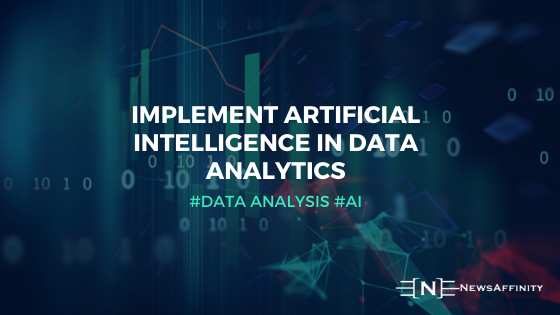Artificial Intelligence is no longer the fad of science fiction movies. Instead, technology has spawned beyond boundaries. Today, every organization plans to revamp its existing infrastructure and add tools and technologies that run on AI.
In fact, the extent of automation has caught the attention of business leaders to such a level that they embed automation at all levels of the organization. Whether it is the sales and marketing team looking for a prospect or it is the IT department testing the feature and functionality of the software, everything is automated.
All of this appears to be legit and does not doom you to rethink how and why. Much because we were idealizing in different sectors, how about adding automation to a process rather than another technology?
Data Analytics, as we all are aware of, is the process undertaken to assess and scrutinize large chunks of data and then predict the future course of action, based on the same.
Until now, it has been seen that data analytics could help organizations make better and smarter decisions by putting their raw data to use. Each day billions of data get generated by enterprises only to be stored and eat up space. Data analytics adds the possibility of studying this data and extracting significant information from the same, one that would foster the growth of the enterprise.
Following a similar notion, artificial intelligence aims at improving the process of data analytics. It is seen that artificial intelligence, when applied to the data analytics process, can effectively improve the result.
Before, we jump on to how let’s have a quick look at why?
Why Implement AI in Data Analytics
Data Analytics, as we know, is the process of collecting, organizing and assessing data to come up with conclusions that influence business decisions. Now, data analytics is just a tool that would on each and every data. Imagine a scenario where you have billions of data.
What the tool would do is process all of the pieces, and generate reports for each. However, amidst this huge pile, there could be few which hardly would affect your decision. Of course, the tool doesn’t have its own intelligence and would not enter into any sort of removal process to focus on the important ones. Instead, it takes everything into account and executes operations that consume a lot of time.
Second, is the need to do more with data. It is no surprise that every organization produces data in large amounts and uses data analytics to extract information. However, this is limited to what you ask or search for. The data analytics tool doesn’t shed insights on data inside out. In order to unleash the true potential, you would need to process the data further and this is where the idea of implementing AI pops in.
Implementing AI in Data Analytics – Strategies
As stated above, data analytics would generate only the information it has been fed in the form of raw data. Also, the reports generated are limited in information. To make the most of the data analytics model, we suggest the implementation of artificial intelligence in it.
There are four different ways to augment artificial intelligence in data analytics and drive maximum benefit.
- Predictive Analysis
We know that data analytics gives us a pool of data that can be used by the organization. Implementing AI to study the data help the model to detect and identify behavioral patterns within the data, map such patterns to different events and then based on the past information, predict what possibly could be the next step of the user.
For instance, consider that there was a campaign hosted to promote beauty products. Data was collected and fed into a data analytics tool to come up with information. The final result would have highlighted the fact that women of a certain region and a certain age have a higher tendency to make a purchase.
On the contrary, AI analytics further predicts which of the regions and additional people would react in the same manner or have a similar trait. The presence of the above information helps the organization to target their product in the right way and increase the business value.
- Prescriptive Analysis
Often, it so happens that you do everything right, deploys a product, stuffed it with features and promoted it best, yet the campaign fails to generate the expected value. How do you change this trait and increase the possibility of sales?
This is where the concept of prescriptive analysis pops into the picture. AI tools help study the data, find the loopholes and then use prediction to determine when and where a customer loses his interest. Also, it helps an organization with suggestions to better their strategy and ensure a higher sale.
- Descriptive Analytics
What this does is generate reports and place them on the dashboard to come up with educated guesses on the occurrence of a particular thing. To put it this way, descriptive analysis is about generating reports in real-time and then deciding what particular decision would trigger a particular action. Based on the above, managers or leaders can make sound and better decisions.
- Diagnostic Analysis
If the descriptive analysis is about what has happened, the implementation of AI further helps dig deeper and find out the why. Why is that the revenue fell below the threshold or why have the users in a certain region denied making a purchase. The outcome of the above helps leaders take certain steps to combat the effect and adopt a better solution.
Final Word
Having said all of the above, it is pretty clear that AI in data analytics will turn the tables for the enterprises. Much of the work done by a data analytics tool is based on rules. Ideation and creation of them consume a lot of time and effort. Putting AI to use would automate the task of generating rules, allowing the professionals to focus on strategies, rather than deploying rules. In order to unleash the true potential of data, it’s time that you went on board and augment AI in data analytics.
Author Profile

Nikhil Bansal is the CEO and Founder of Apptuix, a leading Mobile App Development Company helping businesses in streamlining their processes with powerful and intuitive mobile apps. With extensive experience in iOS app development, he has established himself as a highly-focused Solution Architect and UX expert, the one who is always ready to make efforts in the direction where technology blends with lives

















Comments